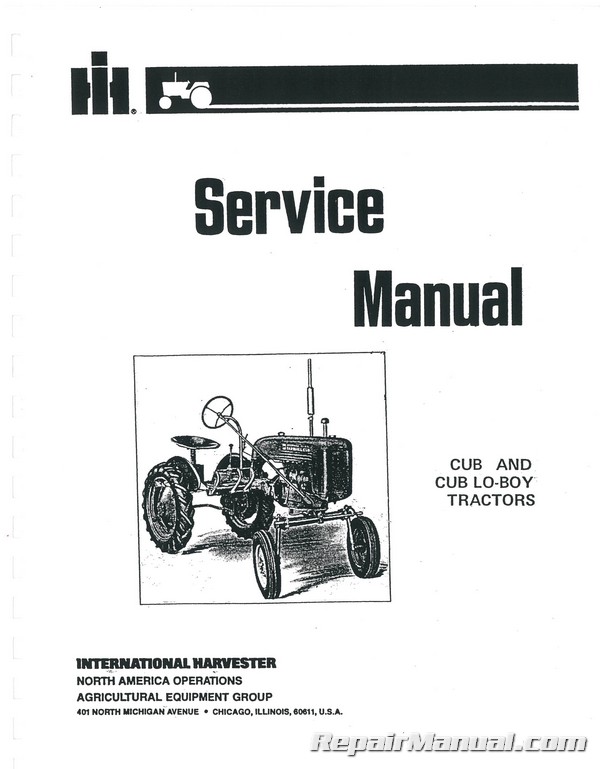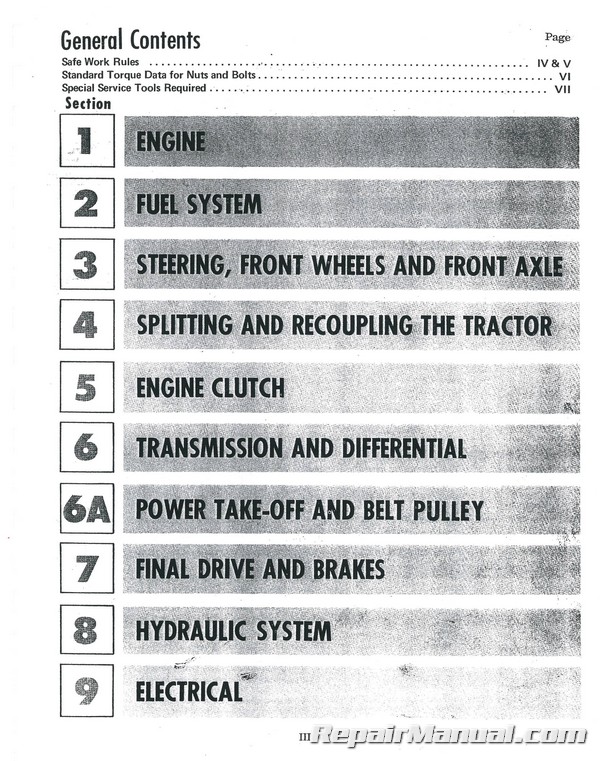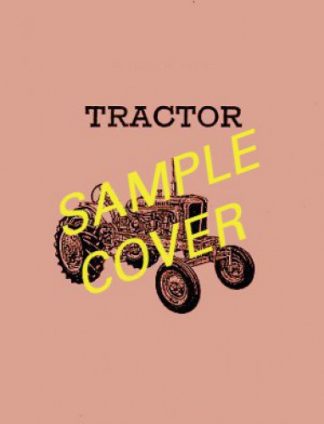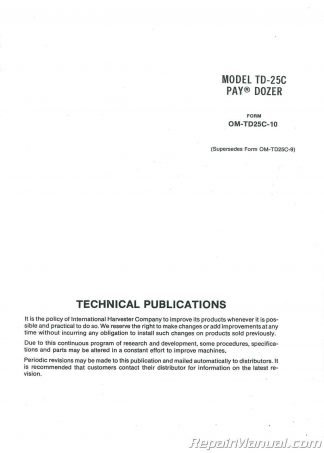Description
This 225 page, International Harvester Cub and Cub Lo-Boy Service Manual is a reproduction of the original out of print factory manual. This manual serves as a comprehensive guide to repairs and provides detailed information, instructions, and specifications for maintaining, repairing, and servicing International Harvester Cub and Cub Lo-Boy tractors.
Table of Contents
Section 1 – Engine
Engine Specifications
Engine Removal
Engine Installation
Cylinder Head
Valves
Valve Lash Adjusting Procedure
Removing Valves
Inspection
General
Valves
Valve Seat Retainer Keys
Valve Guides
Valve Seats
Rotocap
Testing Rotators
Reconditioning
Valve Guides
Valves
Valve Seats
Refacing Seats
Reassembly
Connecting Rods, Pistons and Piston Rings
General
Connecting Rods
Pistons
Piston Rings
Piston Pins
Removal
Disassembly
Inspection and Repair
Reassembly
Piston Fit in Bore
Bearing Fitting Procedure
Installation
Crankcase Cylinder Re-Boring Procedure
When to Re-Bore
Preparing the Block
Re-Boring
Honing
Cleaning
Checking Clearance
Timing Gear Train and Front Cover
General
Camshaft
General
Crankshaft and Main Bearings
General
Lubricating Oil Pump
General Description
Gil Pump
Pressure Regulator Valve
Removal and Disassembly
Inspection and Servicing
Reassembly
Cooling System
General Description and Operation
Removal of Radiator Assembly
Inspection and Repair
Installation of Radiator Assembly
Cooling Fan Service
Troubleshooting
Tune-Up
Section 2 – Fuel System
Fuel System Specifications
Carburetor
General Description
Carburetor Operation
Liquid Level Check (carburetor on Engine)
Removal and Installation of Carburetor
Inspection and Repair
Assembly and Adjustment
Diagnosing Engine Troubles
Governor
Principles of Operation
Removal, Inspection and Repair
Installation and Adjustment
Section 3 – Steering, Front Wheels and Front Axle
Specifications
Front Wheels and Bearings
Removal
Inspection and Repair
Installation
Removal and Disassembly of Front Axle Assembly
Inspection and Repair
Reassembly and Installation of Front Axle Assembly
Steering Assembly
Removal
Disassembly
Inspection and Repair
Reassembly
Installation
Adjusting the Toe-In
Section 4 – Splitting and Recoupling the Tractor
Front Section Split
Recoupling
Rear Section Split
Recoupling
Section 5 – Engine Clutch
Specifications
Removal
Disassembly
Inspection and Repair
Reassembly
Installation
Clutch Adjustment
Section 6 – Transmission and Differential
Specifications
General
Removal
Disassembly
Differential,
Transmission
Inspection and Repair
Reassembly and Installation
Section 6A – Power Take-Off and Belt Pulley
Specifications
Belt Pulley
Removal and Disassembly
Inspection and Repair
Reassembly and Installation
Power Take-Off
Removal
Disassembly
Inspection and Repair
Reassembly
Installation
Section 7 – Final Drive and Brakes
Specifications
Final Drive
Removal
Disassembly
Differential Shaft
Rear Axles
Inspection and Repair
Reassembly
Rear Axles
Differential Shafts
Installation
Brakes
Removal
Inspection and Repair
Installation
Brake Adjustment
Section 8 – Hydraulic System
Specifications
General
Cleaning
Handling of O-Rings
Principles of Operation
Hand Control and Rockshaft at Rest,
Oil Circulating at Low Pressure
Hand Lever Moved to Lower Implement,
Showing Path of Oil to And from Rockshaft Piston
Hand Lever Moved to Raise Implement,
Showing Path of Oil to And from Rockshaft Piston
Removal
Disassembly
Touch-Control Pump
Cylinder Block
Inspection and Repair
Reassembly
Installation
Trouble Shooting Test Procedure
General
Procedure
Trouble Shooting Chart
Section 9 – Electrical
Specifications
Timing
Distributor
Dwell Angle
Magneto
Alternator
Generators
Voltage Regulators
Cranking Motor
Wiring Diagram
Here’s what you can typically expect to find in such a manual and why it is a valuable purchase:
Technical Specifications: Detailed specifications about the tractor’s engine, transmission, hydraulic system, electrical system, and other key components.
Maintenance Procedures: Scheduled maintenance tasks, including fluid changes, filter replacements, lubrication points, and overall inspection guidelines to keep the tractor in optimal condition.
Repair Procedures: Step-by-step instructions for diagnosing and repairing specific issues that may arise. This includes guidance on troubleshooting problems in the engine, transmission, brakes, steering, and other systems.
Adjustment Procedures: Instructions for making adjustments to various components to ensure proper operation. This may include adjustments to the clutch, brakes, steering, and other critical systems.
Electrical Diagrams: Wiring diagrams and electrical schematics to assist with troubleshooting and repairing electrical issues. This section is crucial for understanding the tractor’s electrical system.
Hydraulic System Information: Details about the tractor’s hydraulic system, including diagrams and procedures for maintenance and repair. This is essential for owners using hydraulic implements.
Special Tools and Equipment: Information about any special tools or equipment needed for specific maintenance or repair tasks. This section ensures that owners are adequately equipped to perform the necessary work.
A service manual provides a detailed understanding of the tractor’s systems and components, empowering owners to troubleshoot issues and make informed decisions about repairs.
Preserving Resale Value: A well-maintained tractor with a documented service history, often based on a service manual, can have a higher resale value. Prospective buyers appreciate the availability of detailed service records.
Safety and Reliability: Proper maintenance and repairs contribute to the tractor’s safety and reliability. A service manual guides owners in performing tasks that contribute to the overall longevity of the tractor. An International Harvester Cub / Cub Lo-Boy Tractor Service Manual is a valuable resource for owners who want to maintain, troubleshoot, and repair their tractors. It serves as a comprehensive guide, ensuring that owners have the necessary information and procedures to keep their tractors in excellent condition.
The International Harvester (IH) Cub and Cub Lo-Boy tractors are compact utility tractors that were manufactured by International Harvester and later by Case IH.
Production Years: The Farmall Cub was produced from 1947 to 1979.
Engine: Typically equipped with a four-cylinder engine.
Features: The Farmall Cub was a small tractor designed for small farms and garden use. It featured a distinctive offset design, allowing it to straddle rows in fields.
International Harvester Cub Lo-Boy:
Production Years: The Cub Lo-Boy models were produced from 1955 to 1968.
Engine: Similar to the Farmall Cub, the Cub Lo-Boy had various engine options.
Features: The Lo-Boy models were designed with a lower profile, making them suitable for mowing and other applications where a lower center of gravity was beneficial.
Common Problems:
While the Cub and Cub Lo-Boy tractors are generally known for their durability and reliability, like any vintage equipment, they may experience certain issues due to age, wear, and maintenance. Some common problems reported by owners include:
Electrical Issues: Older tractors may have electrical problems, including issues with the ignition system, wiring, or lighting.
Engine Problems: Depending on the tractor’s age and maintenance history, engine-related issues such as oil leaks, worn-out components, or problems with carburetion may arise.
Transmission and Clutch: Some owners have reported issues with the transmission, such as difficulty shifting or problems with the clutch.
Hydraulic System: Leaks or malfunctions in the hydraulic system may occur, affecting the tractor’s ability to lift implements.
Steering and Front-end Issues: Wear in steering components or problems with the front-end alignment may be encountered.
PTO and Belt Issues: Problems with the power take-off (PTO) system or belt-driven accessories may need attention.
It’s important to note that many of these tractors are now considered vintage or antique, regular maintenance and inspections by a knowledgeable mechanic can help identify and address potential issues before they become major problems. A well-maintained and cared-for Cub or Cub Lo-Boy can provide many years of reliable service.



 SKU: JS-IH-S-400
SKU: JS-IH-S-400 SKU: JS-IH-O-B
SKU: JS-IH-O-B SKU: IH-O-TD25C
SKU: IH-O-TD25C

